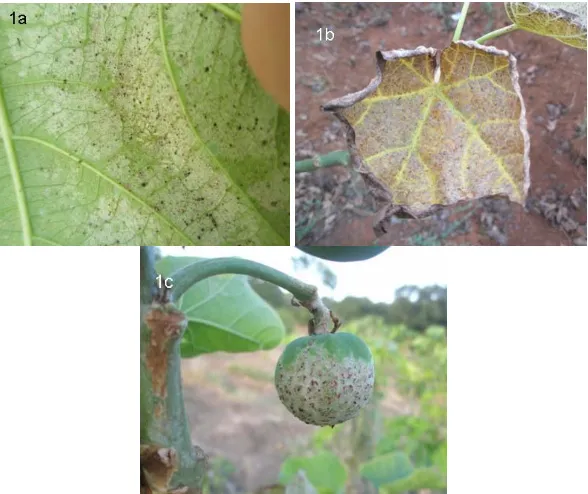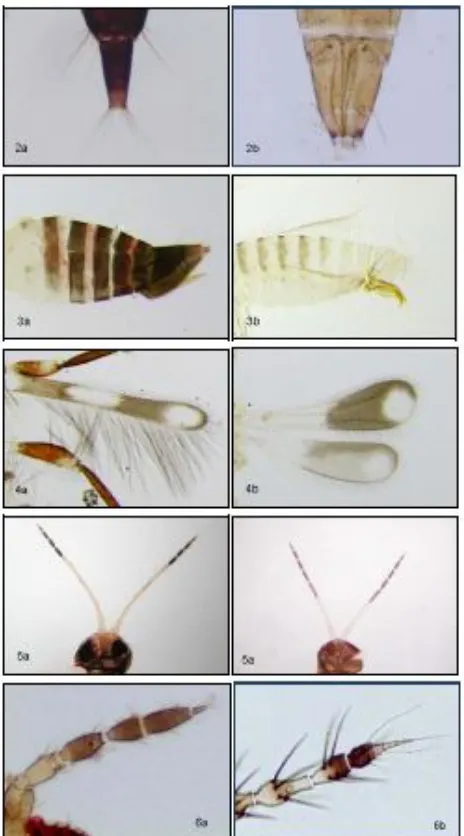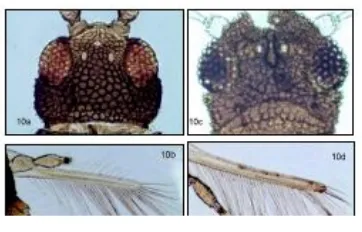PHYSIC NUT THRIPS DIVERSITY
Nur Asbani1*) and Dewi Sartiami2)
1)
Indonesian Research Institute of Tobacco and Fiber Crops Jl. Raya Karangploso P.O. Box. 199, Malang 65152 East Java Indonesia 2)
Department of Plant Protection Faculty of Agriculture Bogor Agricultural University Jl. Meranti Kampus IPB Darmaga, Bogor 16680 West Java Indonesia
*)
Corresponding author Phone: +62-341- 491447 E-mail: [email protected]
Received: June 23, 2010/ Accepted: May 2, 2011
ABSTRACT
Physic nut (Jatropha curcas L.) is a relatively new agricultural crop commodity in Indonesia. Hence, the thrips associated with this plant are not well recognized. The research objective was to provide information and tool for identification of thrips associated with physic nut. Survey Aeolothripidae and Phlaeothripidae and one unidentified species. The Thripidae species were Selenothrips rubrocintus, Rhipiphorothrips pulchellus, Thrips hawaiiensis, Heliothrips hae-morrhoidalis, Zaniothrips ricini and Scolothrips sexmaculatus. The family Aeolothripidae were Franklinothrips vespiformis, F. variegatus and Mymarothrips bicolor; the only one of Phlaeo-thripidae was Ecacanthothrips tibialis. The identification key had been built for all species mentioned above. These thrips can be grouped into herbivore, carnivore, and fungivore.
Keywords: Jatropha curcas, thrips, diversity
INTRODUCTION
Physic nut (Jatropha curcas L.) is an oil crop which can be used for biofuel. Biofuel produced from physic nut oil has some advantages; it helps with cleaner combustion process and produces lower pollutant. In the future, a huge area and intensive cultivation will be a possible thing.
This crop is known to have substances which are toxic to many groups of organism such as insect, mollusca, fungi, nematode, fish,
aves, and mamalia included human (Gubitz et al., 1999; Makkar and Becker, 1999). This toxic effect is caused by curcin and diterpen esthers content which are predicted to cause resistance of physic nut to pest attack. Asbani et al. (2006) and Asbani et al. (2007) reported pest on physic nut was Selenothrips rubrocinctus, Rhipiphoro-thrips pulchellus, mealybug, Chrysocoris, leaf miner, and seed borer. At least 15 species of heteroptera attack physic nut in Nicaragua (Shanker and Dyani 2006). The major pests already recognized are bud mites Polyphago-tarsonemus latus and Eriophyid, as well as two species of thrips i.e. Selenothrips rubrocinctus and Rhipiphorothrips pulchellus.
Thysanoptera or thrips is characterized by its fringed wing, small size, and asymetric mouth-part. About 6000 thrips species has already recognized in the world (Mound and Morris, 2007). On the other hand, thrips diversity information on physic nut is limited. This information has an important role for an effective management technology such as biological control program, cultural control and plant resistant development. It is important to gather such information by surveying thrips on physic nut in some areas. The research was directed to provide information of thrips diversity which was associated with physic nut and its identification keys.
MATERIALS AND METHODS
The research was conducted from 2006 to 2009. The locations of survey were in Sukabumi, Yogyakarta, Blora, Pati, Kediri, Blitar, Malang, Pasuruan, Lumajang, Jember, Situbondo, Lombok, and Madura. Specimens were taken from flower, fruit, leaf, stem, and even from the dead physic nut. Collected thrips
were preserved in alcohol glycerin acetic acid (AGA) solution, subsequently transfered to Hoyer’s as mounting media for identification purposes.
Specimen identification was based on both qualitative and quantitative morphological characters. Identification keys and descriptions followed taxonomic reference such Mound and Monteiro (1997), Mound and Kibby (1998), Mound and Marullo (1998), Mound et al. (2001), Mound and Reynaud (2005), Mound and Azidah (2009), Mound and Ng (2009), Palmer and Mound (1978), including personal commu-nication with Laurence A. Mound (thrips taxono-mist of CSIRO Entomology).
RESULTS AND DISCUSSION
Surveys found ten identified thrips species, while the only one unidentified thrip collected from bud and young leaves attacked by Paniculatus curcasis (Xue and Zhang, 2009). These thrips were probably predators of this mite. Morphological identification faced diffi-culties for such specimen because only
immature thrips were found whereas most of thrip identification key was based on adult female morphology.
All of the species were collected from the entire part of this crop i.e. flower, leaves, stem, and even dead branch or wood. They showed a diverse way of living but it could mainly be classified into phytophagous, detrivorous, and predator.
Three herbivore thripsnamely Selenothrips cruentatus, Rhipiphorothrips pulchellus, and Helio-thrips haemorrhoidalisgave similar symptom when they attacked leaves and fruits. Their mouthparts suck cytoplasm, therefore the emptied cytoplasm cell will be replaced by air or air filled cell (Fung et al., 2001). Mild attacks gave silvery areas on lower surface of leaves which would develop into brown necrotic areas. (Figure 1). Serious attack caused leaf wilting and defoliation, then finally reduced fruit production.
Only adult female was used for identi-fications. Morphological characters important for this purpose were antennae, head, wings, thorax, abdomen, and ovipositor. Identification key was built based on these characters.
Physic Nut Thrips Identification Key
1a. Forewings without veins and setae; the last abdominal segment in tubelike shape (Figure
2a) TUBULIFERA (Phlaeothripidae) …….
Ecacanthothrips tibialis
1b. Forewings with vein and setae; non-tubelike last abdominal segment (Figure 2b)
TEREBRANTIA ……….………2
Thysanoptera order is devided into two suborder i.e. Tubulifera and Terebrantia. Tubuli-fera can be recognized easily from its tubelike or tubular shape of last abdominal segment or the 10th segment. This suborder has only one family namely Phlaeothripidae. Terebrantia is different, its abdominal segment is conical or rounded and the female mostly has an ovipositor.
2a. Ovipositor turned upward (Figure 3a), forewings broad with several cross vein;
(Aeolothripidae) ……….. 3
2b. Ovipositor turned downward (Figure 3b); forewings narrow with one cross vein; 7-8 segments antennae, segment I-IV length about 3-4 times of width ...5
3a. Forewings in raquet shape (Figure 4a); antennae segment III-VII almost in the same length; abdomen not constricted ...
Mymarothrips bicolor
3b. Forewings not in raquet shape (Figure 4b); 9 segments of antennae, very long segments III-IV, segments III-VII gradually shorter, segment III with the length of 15 times broader; abdomen I-IV constricted (Franklinothrips)...4
4a. Antennal segment IV yellow if dark only on apex (Figure 5a); white abdomen tergit I-IV while the rest in dark colour ...
Franklinothrips variegatus
4b. Antennal segment IV in dark brown (Figure 5b); white abdomen tergit I-II while the rest in dark colour ...Franklinothrips vespiformis
5a. Terminal of antennal segment not elongate (Figure 6a) (Thripinae) ...6
5b. Terminal of antennal segment elongate (Figure 6b) (Panchaetothripinae) ...7
6a. Pronotum with 6 pairs of long setae (Figure
8a. Posterior margin of pronotum with 3 pairs of long setae and 1 pair on anterior margin; antennal segment IV with long apical neck (Figure 9a) ...Zaniothrips ricini
8b. Pronotum without such long setae (Figure 9b) ...Selenothrips rubrocinctus
9a. Head with polygonal reticulation (Figure 10a); anterior margin of forewings with cilia (Figure 10b) …………..Heliothrips haemorrhoidalis
9b. Head with irregular reticulation (Figure 10c); anterior margin of forewings without cilia (Figure 10d) ...Rhipiphorothrips pulchellus
1. Ecacanthothrips tibialis Ashmead
Figure 7-9. Pronotum of S. sexmaculatus (7a) and T. hawaiiensis (7b); fore wing of S. rubrocinctus (8a) and H. haemorrhoidalis (8c); antennae of S. rubrocinctus (8b) and H. haemorrhoidalis (8d); pronotum of Z. ricini (9a) and S. rubrocinctus (9b).
2. Mymarothrips bicolor zur Strassen
Mymarothrips bicolor was characterised by its raquet shape of forewings and cross vein on its costa. The female length was about 1.83-2.05 mm and 1.95 mm in average, while the male’s was smaller i.e. 1.46 mm. Antennae was divided into 7 segments and each segment had many long setae.
Polymorphism occurs in this species, especially on the body colour. The first was paler species with pale costal region and without dark marking on the forewings apex. Head and pronotum was just plain pale brown. The other was black brownish species with dark costal region and dark marking on forewings apex. The head was brown with white part in the middle which was continued to pronotum, mesonotum, as well as metanotum.
Both of the larvae and adults are predators equipped with high mobility which could be species was mostly collected from Sukabumi, Pati, Kediri, Malang, Situbondo, Jember, and Lombok.
3. Franklinothrips variegatus Girault
Ant mimicry was a morphological character which could be easily recognized of the genera, especially in the adult female. This feature was a consequency of constriction on abdominal segment I and II which produce a petiole like of ant. Adult female was about 2.48 mm, black in colour, and had white band on basal abdomen. Larva was whitish with red mark. Both the adult and larva were active moving insects which would be useful for catching prey.
Antennal segment III-IV was definitely long and slender. The length of segment III was at least 8 times as much as its width. The head was without any long setae. Anterior half part of mesonotum was not sculptured. Forewings were slender, and cilia existed on costa. This species was collected from the greenhouse of The Indonesian Tobacco and Fiber Crops Research Institute (IToFCRI), Malang, and they were associated with S. rubrocinctus and Eutetranychus banksi.
4. Franklinothrips vespiformis Crawford DL
General morphology of Franklinothrips vespiformis was similar to F. variegatus. Both of the species could be easily distinguished on its antennae and abdomen. The former had a dark brown antennal segment IV and whitish abdominal band was on tergit I-II, whilst the latter has bright colour or whitish of antennal segment IV and whitish abdominal was on tergit I-IV. Adult length was about 2.15-2.78 mm or an average 2.49 mm. A pale area was present on its apical forewings. This species lived in association with S. rubrocinctus and R. pulchellus, presumably was its predator. It was found in Pati, Malang, and Situbondo.
5. Scolothrips sexmaculatus (Pergande)
Adult of Scolothrips sexmaculatus was whitish with 3 black spot on each forewing. Specific morphological characters of this species was the long setae on head and pronotum as well as black band on abdomen (Mound and Walker, 1987). Adult was about 1.33 mm in length average. Both of the larvae and adult are known as predator of Panonychus citri, Tetranychus urticae Koch, Eotetranychus banksi (Riley), Bryobia praetiosa Koch, and the other tetranychid as well as eriophyid Phyllocoptruta oleivora (Childers and Nakahara, 2006; Mound and Kibby, 1998). This specimen was found in Malang and Sukabumi.
6. Thrips hawaiiensisMorgan
Adult of Thrips hawaiiensis had yellow thorax and legs, whilst abdomen was brown and wings was pale brown. Larvae had paler colour than adult. Antennae was 7 segment, segment I and III yellow but the rest was brown. Body length of female was between 1.23-1.63 mm or 1.46 mm average. This species had a complete posteromarginal comb of microtrichia on 8th tergite. Specimens was collected from Sukabumi, Pati, Malang, Lumajang, Situbondo, and Jember. The thrips could be easily found on male, female, and hermaphrodite flowers. Both larvae and adult consumed pollen and nectar of developing flower, so that caused malformation and lower of fruit set formation (Childers and Nakahara, 2006).
7. Zaniothrips riciniBhatti
1.68-1.83 or 1.74 on average and they would fly away if disturbed. Specimen was found in Pati, Situbondo, Jember, and Malang. Formerly, this species was recognized as a pest of Ricinus communis or castor (Daniel et al., 1983).
8. Selenothrips rubrocinctus Giard
Selenothrips rubrocinctus was black colour thrips. The forewings had 2 rows of long setae. The larva was whitish with red band on abdomen, and terminal of abdomen had some long setae. The length of adult female was just about 1.38-2.13 mm or 1.62 mm on average, while the male’s was a little bit shorter, which was about 1.44 mm. The male was rare in field or natural population. This kind of thrips was collected from Sukabumi, Ciamis, Yogyakarta, Pati, Kediri, Blitar, Malang, Pasuruan, Lumajang, Situbondo, and Jember.
Attacked leaves had silvery layers on their lower surface. Furthermore, brown spots of thrip liquid secretion, and it produced necrosis. The pest could cause wilt and complete defoliation to physic nut leaves.
9. Heliothrips haemorrhoidalisBouche
Heliothrips haemorrhoidalis larva was yellowish white, while the adult was dark brown, and the legs were white yellowish or brighter colour, as well as the abdomen terminal. Adult polygonal reticulation was strong on its body; the length was around 1.43-1.60 mm or 1.54 mm in average. Terminal of its eight antennal segments was elongate and needle like. Antennal segment II, VII, and VIII were yellow, and simple sensoria were also on segment III and IV. The young adult was brighter in colour. Polygonal reticulation of the body and legs was apparent or clear, whereas it was not clear on abdominal tergum.
The specimen was found only on physic nut and crossing with Jatropha integerrima grown in the greenhouse of IToFCRI, Malang. It attacked mature leaves which produced a silvery layer on lower surface of leaves. A serious attack caused an early defoliation.
10. Rhipiphorothrips pulchellus Morgan
Larvae of Rhipiphorothrips pulchellus were white and had some long setae on abdomen terminal. Head and thorax of adult female were dark brown, whereas abdomen was brighter in colour. The front part of the head
was rounded and has a strong irregular reticulation. The antenna was divided into 8 segments having a simple sensory on segment III and IV along with yellow of segment I-IV. The anterior margin of forewings was without cilia, except fine setae. The forewings terminal or tip was rounded. The adult length was 1.05-1.98 mm or 1.76 mm in average. The specimen was collected from Ciamis, Kediri, Blitar, Situbondo, Jember, and Lumajang.
CONCLUSIONS
Ten species of thrips found were asso-ciated with physic nut; they comprised Eca-canthothrips tibialis, Mymarothrips bicolor, Fran-klinothrips variegatus, F. vespiformis, Scolo-thrips sexmaculatus, Thrips hawaiiensis, Zanio-thrips ricini, Selenothrips rubrocintus, Heliothrips haemorrhoidalis, and Rhipiphorothrips pulchellus. Based on their feeding habit, they could be classified as phytophagous, detrivorous, and predatory thrips.
AKNOWLEDGEMENTS
I thank to Dr. Laurence A. Mound, a thrips taxonomist of CSIRO Entomology.
REFERENCES
Asbani, N., A.M. Amir and Subiyakto. 2006. Inventarisasi Hama Jarak Pagar. Pro-ceeding of Lokakarya Jarak Pagar II. Bogor 29 November 2006.
Asbani, N., A.M.Amir, Subiyakto and D. Winarno. 2007. Inventarisasi, ekobiologi dan pengendalian hama jarak pagar. Balittas Project Report 2007.
Childers, C.C. and S. Nakahara. 2006. Thysa-noptera (thrips) within citrus orchards in Florida: Species distribution, relative and seasonal abundance within trees, and species on vines and ground cover plants. Journal of Insect Science 6(45): 1-19
Fung, S.Y., I. Kuiper, .CM. van Dijke-Hermans and E. van der Meijden. 2001. Growth damage and silvery damage in chry-santhemum caused by Frankliniella occidentalis is related to leaf food quality. In: Proceedings of The 7th International Symposium on Thysanoptera.
Gubitz, G.M, M. Mittelbach and M Trabi. 1999. Exploitation of the tropical oil seed plant Jatropha curcas L. Bioresource Techno-logy (67): 73-82.
Makkar, H.P.S. and K. Becker. 1999. Plant toxins and detoxification methods to improve feed quality of tropical seeds. Journal of Animal Science (12)3: 467-480.
Mound, L.A .and A.K. Walker. 1987. Thysa-noptera as tropical tramps: new records from New Zealand and the Pacific. New Zealand Entomologist (9): 71-85. Mound, L.A. and R.C. Monteiro. 1997. A review
of the genus Heliothrips (Thysanoptera: Thripidae), with a new sister species of the greenhouse thrips from eastern Brazil. Journal of New York Entomology Society (105): 154-160
Mound, L.A.and R. Marullo. 1998. Biology and identification of Aeolothripidae (Thysa-noptera) in Australia. Invertebrate Taxo-nomy (12): 929-950.
Mound, L.A. and G. Kibby. 1998. Thysanoptera: an Identification Guide. Wallingford: CAB International.
Mound, L.A., R. Marullo and J.W.H. Trueman. 2001. The greenhouse thrips, Helio-thrips haemorrhoidalis, and its generic relationships within the subfamily Pancahaetothripinae (Thysanoptera: Thripidae). Insect Systematics Evolution 32: 205-216.
Mound, L.A. and P. Reynaud. 2005. Franklino-thrips; a pantropical Thysanoptera genus of ant-mimicking obligate predators (Aeo-lothripidae). Zootaxa 864: 1–16
Mound, L. A. and D.C. Morris. 2007. The insect Order Thysanoptera: Classification versus Systematics. Zootaxa 1668: 395–411. Mound, L.A. and A.A. Azidah. 2009. Species of
the genus Thrips (Thysanoptera) from peninsular Malaysia, with a checklist of recorded Thripidae. Zootaxa (2023): 55-68.
Mound, L.A .and Y. F. Ng. 2009. An illustrated key to the genera of Thripinae (Thysa-noptera) from South East Asia. Zootaxa 2265: 27–47
Palmer, J.M. and L.A. Mound. 1978. Nine genera of fungus-feeding Phlaeothri-pidae (Thysanoptera) from oriental region. Bulletin of British Museum Natural History (Ent) 37(5):153-215. Shanker, C. and S.K. Dhyani. 2006. Insect
pests of Jatropha curcas L. and the potential for their management. Current Science 91(2): 162
Xue, X. and Z. Zhang 2009. Eriophyoid mites (Acari: Prostigmata) in Southeast Asia: a synopsis of 104 genera, with an illustrated key to genera and checklist of species Zootaxa 2257: 1–128


